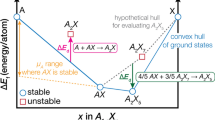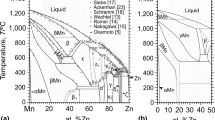Abstract
Approximated equations have been constructed to describe the temperature (T) dependence of the molar volumes (V) of fcc solid metals (Ag, Al, Au, Cu, Ir, Ni, Pb, Pd, Pt, and Rh) and their liquids below and above their melting points at standard pressure of 1 bar from zero Kelvin. Below the melting point, the following new approximated equation is suggested for both the solid and liquid metals: V = a + b * T (to the power of n), where a, b, and n are semi-empirical parameters (at n larger than 1; this equation obeys the boundary condition that the thermal expansion coefficient becomes zero at T = 0 K). This approximated equation reproduces the measured molar volume of solids from zero Kelvin to melting point with an accuracy of 0.2 % or better. As a compromise, the derivative of this equation reproduces the measured thermal expansion coefficient of solids only with an accuracy 10 % or better and only above 100 K. Above the melting point, the following well-known equation is used for both liquid and solid phases: V = c + d * T, where c and d are semi-empirical parameters. This equation implies that the thermal expansion coefficient above the melting point has an approximately constant value. It is found that the volume change upon melting extrapolated to zero K is about 58 % of that at the melting point for all the 10 fcc metals. The tabulated 4 equations (below and above the melting point/for fcc and liquid states) are provided for each of the 10 fcc metals. These equations will be useful for estimating phase equilibria of nano-materials.






Similar content being viewed by others
Notes
the exception is Ni, for which the parameters of Table 1 in [22] are probably given with a misprint.
References
Paradis PF, Ishikawa T, Lee GW, Holland-Moritz D, Brillo J, Rhim WK, Okada JT (2014) Materials properties measurements and particle beam interactions studies using electrostatic levitation. Mater Sci Eng R 76:1–53
Kobatake H, Schmitz J, Brillo J (2014) Density and viscosity of ternary Al–Cu–Si liquid alloys. J Mater Sci 49:3541–3549. doi:10.1007/s10853-014-8072-z
Poirier DR (2014) Density, viscosity, and diffusion coefficients in hypoeutectic Al–Si liquid alloys: an assessment of available data. Metal Mater Trans B. doi:10.1007/s11663-014-0037-8
Gancarz T, Moser Z, Gasior W, Pstrus J, Henein H (2011) A comparison of surface tension, viscosity, and density of Sn and Sn–Ag alloys using different measurement techniques. Int J Thermophys 32:1210–1233
Terzieff P (2010) Some physico-chemical properties of liquid Ag–Sn–Zn. Phys. B 405:2668–2672
Hallstedt B, Dupin N, Hillert M, Höglund L, Lukas HL, Schuster JC, Solak N (2007) Thermodynamic models for crystalline phases. Composition dependent model for volume, bulk modulus and thermal expansion. CALPHAD 31:28–37
Kucharski M, Fima P (2004) The surface tension and density of Cu–Pb–Fe alloys. Arch Metall Mater 49:565–573
Lu XG, Selleby M, Sundman B (2005) Implementation of a new model for pressure dependence of condensed phases in Thermo-Calc. CALPHAD 29:49–55
Guenther G, Guillon O (2014) Models of size-dependent nanoparticle melting tested on gold. J Mater Sci 49:7915–7932. doi:10.1007/s10853-014-8544-1
Lee J, Sim KJ (2014) General equations of CALPHAD-type thermodynamic description for metallic nanoparticle systems. CALPHAD 44:129–132
Kaptay G, Janczak-Rusch J, Pigozzi G, Jeurgens LPH (2014) Theoretical analysis of melting point depression of pure metals in different initial configurations. J Mater Eng Perform 23:1600–1607
Junkaew A, Ham B, Zhang X, Arróyave R (2014) Tailoring the formation of metastable Mg through interfacial engineering: a phase stability analysis. CALPHAD 45:145–150
Sopousek J, Vrestal J, Pinkas J, Broz P, Bursik J, Styskalik A, Skoda D, Zobac O, Lee J (2014) Cu–Ni nanoalloy phase diagram: prediction and experiment. CALPHAD 45:33–39
Garzel G, Janczak-Rusch J, Zabdyr L (2012) Reassessment of the Ag–Cu phase diagram for nanosystems including particle size and shape effect. CALPHAD 36:52–56
Kaptay G (2012) Nano-Calphad: extension of the Calphad method to systems with nano-phases and complexions. J Mater Sci 47:8320–8335. doi:10.1007/s10853-012-6772-9
Tang C, Sung YM, Lee J (2012) Nonlinear size-dependent melting of the silica-encapsulated silver nanoparticles. Appl Phys Lett 100:201903
Koukkari P, Pajarre R, Hack K (2007) Constrained Gibbs energy minimization. Int J Mater Res 98:926–934
Touloukian YS, Kirby RK, Taylor RE, Lee TYR (1977) Thermal expansion. IFI/Plenum, New York
Emsley J (1989) The elements. Clarendon Press, Oxford
Lide DR (ed) (1993–1994) CRC Handbook of chemistry and physics. CRC Press, Boca Raton
Iida I, Guthrie RIL (1993) The physical properties of liquid metals. Clarendon Press, Oxford
Lu XG, Selleby M, Sundman B (2005) Assessments of molar volume and thermal expansion for selected bcc, fcc and hcp metallic elements. CALPHAD 29:68–89
Lu XG, Selleby M, Sundman B (2005) Theoretical modeling of molar volume and thermal expansion. Acta Mater 53:2259–2272
Arblaster JW (1997) Crystallographic properties of platinum. Plat Met Rev 41:12–21
Arblaster JW (1997) Crystallographic properties of rhodium. Plat Met Rev 41:184–189
Arblaster JW (2006) Crystallographic properties of platinum. New methodology and erratum. Plat Met Rev 50:118–119
Arblaster JW (2010) Crystallographic properties of iridium. Plat Met Rev 54:93–102
Arblaster JW (2012) Crystallographic properties of palladium. Plat Met Rev 56:181–189
Ishikawa T, Paradis PF, Fujii R, Saita Y, Yoda S (2005) Thermophysical property measurements of liquid and supercooled iridium by containerless methods. Int J Thermophys 26:893–904
Paradis PF, Ishikawa T, Saita Y, Yoda S (2004) Containerless property measurements of liquid palladium. Int J Thermophys 25:1905–1921
Ishikawa T, Paradis PF, Koike N (2006) Non-contact thermophysical property measurements of liquid and supercooled platinum. Jpn J Appl Phys 45:1719–1728
Paradis PF, Ishikawa T, Yoda S (2003) Thermophysical property measurements of supercooled and liquid rhodium. Int J Thermophys 24:1121–1136
Dinsdale AT (1991) SGTE data for pure elements. CALPHAD 15:317–425
Paradis PF, Ishikawa T, Koike N (2008) Density of liquid gold measured by a non-contact method. Gold Bull 41:242–245
Chung SK, Thiessen DB, Rhim WK (1996) A noncontact measurement technique for the density and thermal expansion coefficient of solid and liquid materials. Rev Sci Instrum 67:3175–3181
Ishikawa T, Paradis PF, Saita Y (2004) Thermophysical property measurement of molten nickel using an electrostatic levitation furnace. J Jpn Inst Met 68:781–786
Kaptay G (2008) A unified model for the cohesive enthalpy, critical temperature, surface tension and volume thermal expansion coefficient of liquid metals of bcc, fcc and hcp crystals. Mater Sci Eng A 495:19–26
Acknowledgements
The authors acknowledge the financial support from the Hungarian Academy of Science, under the grant number K101781 and the “Science and Industry: the road from scientific achievements to social benefits” TÁMOP-4.2.3.-12/1/KONV-2012-0029 project supported by the European Union and co-financed by the European Social Fund. This work was partially carried out in the framework of the Center of Applied Materials Science and Nano-Technology at the University of Miskolc.
Author information
Authors and Affiliations
Corresponding author
Rights and permissions
About this article
Cite this article
Kaptay, G. Approximated equations for molar volumes of pure solid fcc metals and their liquids from zero Kelvin to above their melting points at standard pressure. J Mater Sci 50, 678–687 (2015). https://doi.org/10.1007/s10853-014-8627-z
Received:
Accepted:
Published:
Issue Date:
DOI: https://doi.org/10.1007/s10853-014-8627-z




